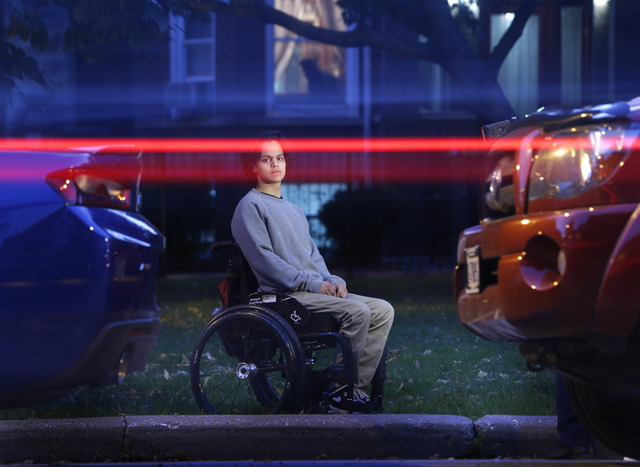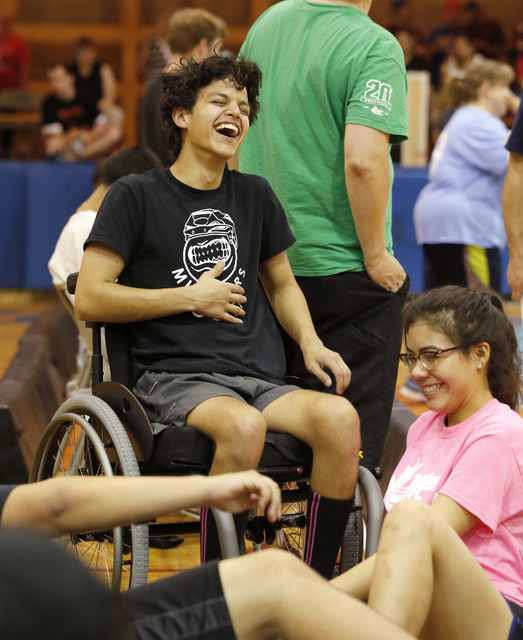CHICAGO — He suddenly felt as if a hot wire had torn through his chest. It hurt to breathe.
CHICAGO — He suddenly felt as if a hot wire had torn through his chest. It hurt to breathe.
Jonathan Annicks wasn’t sure he’d been shot. It was after midnight when he’d dashed outside his family’s house to retrieve a phone charger from the car. Now, slumped over in anguish, he frantically punched his brother’s number into his phone.
“You might have to take me to the hospital,” he gasped. “Come outside, please!”
A hooded stranger had jumped from a van, fired seven shots, then sped away. Incredibly, only one struck Jonathan. The 9 mm bullet plowed into his left shoulder, punctured both lungs, fractured his spine and lodged in his right side of his rib cage under his arm.
At 18, Jonathan’s life was about to take a cruel detour.
___
It was early April and there already were signs that 2016 was going to be a very violent year in Chicago. By fall, the city’s homicide rate approached 600. Shootings exceeded 3,000. Gangs and guns — on average, police seized an illegal weapon every 61 minutes — are the major culprits.
More than 70 percent of those killed here this year were on a special police list of people with criminal records of gang histories. But there are others who’ve been caught up in the mayhem: victims of robbery, mistaken identity, stray bullets or gang crossfire. Some incidents are particularly heinous, others inspirational.
Jonathan Annicks’ story is both, a life transformed, but not defined, by a single bullet. His injury had devastating consequences. He’s now paralyzed from the mid-chest down. The bullet missed his heart by an inch, severely bruising his spinal cord. Over the past six months, his journey has been marked by resilience, change and a determination to look ahead.
“I couldn’t stress about why I had been shot,” he says. “It wasn’t worth if to stay sad because then I would just be making my life harder and I realized that very quickly. … There was no point in sulking over something I couldn’t change.”
Jonathan was shot on April 10 in Little Village, a neighborhood about 20 minutes from downtown. The community, which has a large Mexican population, is home to cozy taquerias, panaderias (bakeries) — but also gangs. Jonathan’s home is on a boulevard that’s a dividing line for opposing Latino gangs, police say, and he may have been mistaken for a rival gang member.
Jonathan says it’s pointless to think about the shooter. “If I lived with spite every day, then I don’t think I would be able to function properly,” he says. “I’d be very miserable if I were worrying about what he’s doing or where he is.”
Instead, he’s focused on rebuilding his strength and learning new ways to get out of bed, shower and dress. He also had to get accustomed to a catheter. It took time, too, to overcome the “why me” feeling and the sense of guilt that he was putting new pressure on his family.
“People had to shape their lives in order to accommodate me,” he says, “but after I realized they were there because they loved me … I didn’t have anything to worry about.”
His mother, Herlinda, has been a steady source of comfort since she told her son in the emergency room: “Whatever the outcome is, you’re still here. You are who you are. We’ll be fine. We’ll deal with it.”
She’s been his cheerleader and champion, juggling her job as a trust bank administrator with taking Jonathan to the doctor and physical therapy, cutting through insurance red tape, helping him each morning — and admonishing him when she thought he was being lazy or selfish.
His brothers, Josh, 17, and Jacob, 14, have pitched in, too. Josh has helped Jonathan in the shower, carried him up and down the stairs and chauffeured him to therapy.
But its Jonathan himself, says his father, Mike, who has been the main source of strength for his family. “He was as positive through the whole thing,” he says, “like everything’s going to be OK.”
Jonathan says he knows his family is watching him closely.
“If I crumble, then I feel like everything around me would, too,” he says. “… I’m just living my life as I would normally and that’s keeping everyone around me sane.”
The transition hasn’t been easy.
Jonathan has endured blood clots and spasms in his legs. He also can’t do many of his favorite things. He was a track and cross-country runner at Payton College Prep, one of the city’s most prestigious high schools, before graduating in June. He also was an avid bicyclist and a sharp-elbowed competitor in floor hockey.
He hopes to get involved in wheelchair sports, but says one thing that annoys him is when people ask what he misses the most. “Do I miss running or do I miss riding my bike? Of course,” he says. “Why would you ask me that?”
Aside from that, Jonathan says, being in a wheelchair hasn’t changed his personality. He’ remains the easygoing kid with a quick grin who likes iced coffee, the Blackhawks and video games. And he has a consistent message: “I’m still the same person. I just can’t use my legs.”
Jonathan’s limited mobility now poses the biggest obstacles at home. The family has decided to stay in its Little Village home but faces the enormous expense of converting it to make it wheelchair accessible and having a ramp or lift built outdoors so Jonathan can get in and out by himself. Someone now carries him or takes him down the six outdoor steps in his chair. A separate fund has been set up to defray his medical costs.
In September, Jonathan began college at DePaul University. His mother escorts him to school and back. “It’s like I’m in kindergarten again,” he says with good-natured frustration.
He’s getting therapy at the Rehabilitation Institute of Chicago. And he’s preparing to get his driver’s license for his Ford Fusion, outfitted with hand controls.
He longs to be on his own.
“I want to be able to get up when I want to, get to school when I have to, go out to eat when I want to … then go home,” he says. “I just want my independence back.”


